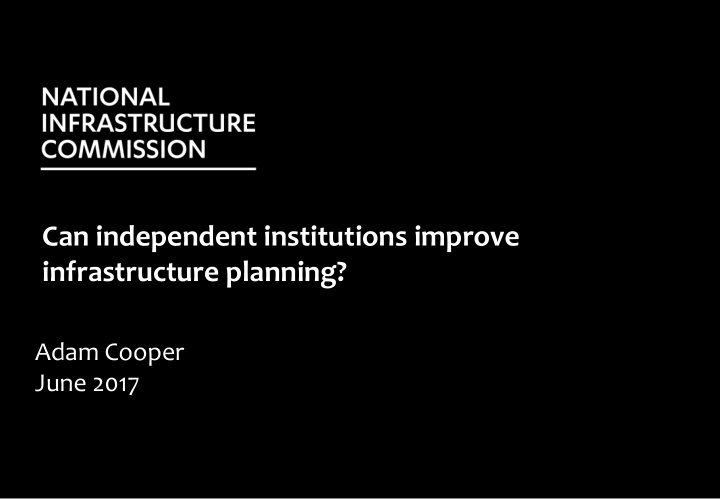



Can independent institutions improve infrastructure planning? Adam Cooper June 2017
Introduction Why do we need independent institutions? How the National Infrastructure Commission works Benefits and responsibilities of independence
The infrastructure challenge THE PAST By 2050 the UK is likely to be… • 15% (10 million) more people – older and more urban • GDP per capita 25% higher under pessimistic THE FUTURE scenarios • 80% reduction in CO2 emissions cf. 1990 • 10 million new homes (330,000 per year)
Growing consensus The creation of the National Infrastructure Commission (NIC) was motivated by a growing consensus among politicians and commentators that the UK’s strategic infrastructure had suffered over recent decades from a legacy of underinvestment and a poor record of long-term planning: “There is growing evidence that the UK’s infrastructure has not been renewed or enhanced when needed…successive Governments have failed to set strategic priorities for infrastructure based on clear projections of future needs .” The Armitt Review (July 2014) “After years of inadequate investment in skills, infrastructure and innovation, there are longstanding structural weaknesses in the economy, all rooted in a failure to achieve stable planning, strategic vision and a political consensus on the right policy framework to support growth .” LSE Growth Commission (January 2013) 4
Set up • Announced Oct 2015, formally constituted Jan 2017 • Agency of HM Treasury, but operational independence protected by Charter • 10 Part-time Commissioners • Chair – Lord Adonis, ex-transport minister • Permanent Secretariat of 35 staff • Multi-year budget
Objectives of the Commission 1. support sustainable economic growth across all regions of the UK; 2. improve competitiveness; and 3. improve quality of life. We do this by: assessing national infrastructure needs over 30 years making recommendations to the government monitoring the government’s progress 6
Sectors covered • Transport • Energy • Digital • Water • Solid Waste • Flood risk • …and the interactions between these sectors and housing 7
The NIC is a catalyst for a new approach From … To … Overly cautious Long term Piecemeal Siloed Independent Slow Stop-start Cross-sectoral Contentious Expensive Transparent & Unreliable Disruption consultative Delayed Strategic Opaque Unplanned Unpredictable
Our work will: • Set a 30 year context for decisions • Enable better decisions to be made at a system level, working across sectors • Be transparent, independent, and based on a robust methodology and evidence • Operate within a broad fiscal envelope 1-1.2% of GDP
Some of the big questions What does a decarbonised energy system look How will like? autonomous vehicles affect transport demand? How will climate How can we change affect manage demand flooding and water for infrastructure supply? services?
Advantages of Independence • Long-term thinking- what’s best for the next 30 years not just the next 5 • Silo-busting and strategic • Unafraid to ask difficult questions • Rigorous, evidence based • Existing policy isn’t a constraint • Less affected by political turbulence
Responsibilities – what must we get right • Credible: high quality analysis and realistic recommendations • Influential: Our work needs impact and support • Forward thinking: See beyond the short term and don’t get buried in the detail
Conclusion Can independent institutions improve infrastructure planning?
nic.org.uk @natinfracom
Recommend
More recommend